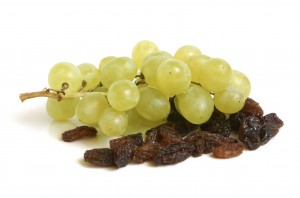When I set out to write this article it was originally “top 5 things” and then it grew into “top 10 things” and ultimately I have concluded there are a lot of dangerous household items pet owners should be aware of!!!
 #15 Grapes and Raisins… I don’t buy grapes or raisins anymore. Some pets will develop acute renal failure after ingesting just one or two grapes OR raisins and it is honestly just too hard to keep track of them. I dropped a yogurt covered raisin not too long ago and you should have seen the crazy dance I did trying to pick it up before my dog got to it… After that I decided it is just too risky…
#15 Grapes and Raisins… I don’t buy grapes or raisins anymore. Some pets will develop acute renal failure after ingesting just one or two grapes OR raisins and it is honestly just too hard to keep track of them. I dropped a yogurt covered raisin not too long ago and you should have seen the crazy dance I did trying to pick it up before my dog got to it… After that I decided it is just too risky…
#14 Caffeine Pills… Many people take caffeine pills to stay awake while studying, working overnight or driving long distances. Caffeine is also in many formulations of diet and fitness supplements. Cats and dogs are very sensitive to the side effects of caffeine and overdose can cause elevations in heart rate, blood pressure, arrhythmias of the heart, tremors and seizures!
#13 Japanese Yew… This is an ornamental plant common in North America and Canada. Clinical signs with toxicity can include severe seizures, cardiovascular collapse and death! All parts of the plant are toxic and this is a large concern for horse owners as they like to graze on the trimmings. Death can occur in horses within minutes!!!
#12 Vitamin D or Bromethalin based rodenticide… Rodenticides are enticing (you have to get the little rodents to want to eat them!) and they are meant to kill. If you must use a rodenticide (versus a live trap etc), consider a long acting anti-coagulant product as they have a readily available antidote that you can obtain from your veterinarian if your pet gets into it (still dangerous, but at least treatable!). Vitamin D causes kidney failure, bromethalin causes swelling of the brain and there is no antidote for either. (Helpful hint: If you use rodenticide USE THE TRAP that comes with the bait station! This is meant to make the poison harder for non-rodents to get at!!!).
#11 Organophosphates… These are a class of insecticides that can cause central nervous system signs, vomiting, diarrhea, excessive salivation and effects to the heart. There are other very safe insecticides available that are just as effective! Stay away from OP based insecticides and ask your veterinarian or pest control officer about safer options.
#10 Golden Malrin… This is fly bait with similar side effects to organophosphates. There are many alternatives that are safer and just as effective! Consider safer alternatives!
#9 Baking xylitol… Baking xylitol is 100% xylitol which means for my dog Theodore who is 22 pounds, it would only take 1/5 of a teaspoon before we would be concerned about serious complications! I have seen dogs eat a pan of baked goods cooked with xylitol and go into liver failure. Use sugar instead!
#8 Metaldehyde … Is an active ingredient in many snail and slugs baits. Ingestion in our pets can lead to severe tremors, seizures and hyperthermia! This stuff is best avoided in homes with pets!
#7 Ethylene Glycol… A common ingredient in anti-freeze, it tastes sweet and pets are often attracted to it. Overdose can result in kidney failure and central nervous system signs. Cats are particularly sensitive and need to be started on the anti-dote within a few hours of exposure to avoid fatality. Only use anti-freeze that is labeled as “pet safe”.
 #6 Lilies… Ingestion of even the pollen can cause acute kidney failure in cats. So in theory your cat doesn’t even have to ingest any of the plant, they might play with it, get pollen on their face and toxicity can be fatal!!! Don’t put the flowers in a closed room, thinking the cat won’t get in there either. Cats are very sneaky and they will find a way in! If lilies are your absolute favorite – keep them at your desk at work!
#6 Lilies… Ingestion of even the pollen can cause acute kidney failure in cats. So in theory your cat doesn’t even have to ingest any of the plant, they might play with it, get pollen on their face and toxicity can be fatal!!! Don’t put the flowers in a closed room, thinking the cat won’t get in there either. Cats are very sneaky and they will find a way in! If lilies are your absolute favorite – keep them at your desk at work!
#5 Calcipotriene/Calcipotrial… This product is a synthetic analog of Vitamin D3 but it is much more potent. Even 2 grams of this product would be toxic to my 22 pound dog. If you are prescribed this for a medical condition, I recommend that you keep it under lock and key!
#4 Isoniazid… This is a first line treatment for tuberculosis. It has a very narrow margin of safety in pets. Clinical signs with overdose can include tremors, seizures, vomiting, diarrhea, arrhythmias, damage to the liver, heart muscle and platelets! Its dangerous stuff, make sure to keep it out of reach for your furry friends!
#3 Baclofen… This is a skeletal muscle relaxant that is commonly prescribed in human medicine. Domestic animals tend to not tolerate it well at all and ingestion can be fatal. Many patients will develop seizures and coma even with a small exposure!
#2 5-Fluorouracil … This is a topical chemotherapeutic drug. We understand that this medication is very necessary for humans who are prescribed it, but we want you to know how bad it can be if your pets get into it! Ingestion can lead to uncontrollable seizures, severe vomiting, bone marrow suppression and death!
#1 Sago Palm… These plants are indigenous to the southern United States. They are pretty interesting looking and they are now available at places like Cub Foods and Ikea as ornamental house plants. Even a small ingestion can cause life threatening liver failure in pets. I would not have these plants in my yard or home.
I hope this article is helpful! Make sure to keep your pets safe by always considering the risk of all household products and taking necessary safety precautions!
About the mechanism and effects of fly bait toxicity in companion animals, as well as the basics of treatment and prevention.
What is Quikstrike Fly Bait?
Quikstrike fly bait is a fast-acting solution for professional house fly control. The bait works to control pesty flies and keeps them from becoming resistant to the bait. The fly bait attracts and kills house flies, and it can be used in commercial premises and in rural areas.
The fly bait contains dinotefuran and (z)-9-tricosene. Dinotefuran is an insecticide that controls many different kinds of insects, including flies. This chemical works by disrupting the insect’s nervous system. (Z)-9-tricosene is an insect pheromone that’s used to attract flies.
It’s interesting to note that dinotefuran is also used in some flea and tick preventives for dogs. But what happens if a dog eats Quikstrike fly bait?
What should I do if my dog is poisoned?
What to do in an emergency
FAQ
Is Quikstrike fly bait harmful to dogs?
QuikStrike Fly Bait is safe to use around children and pets when applied according to the label instructions.
Will fly bait kill a dog?
What do I do if my dog ate fly bait?
What does Quikstrike fly bait kill?